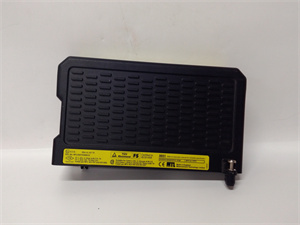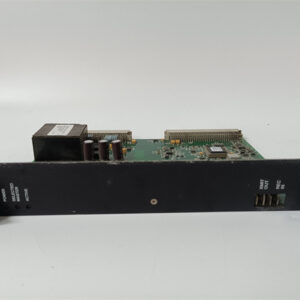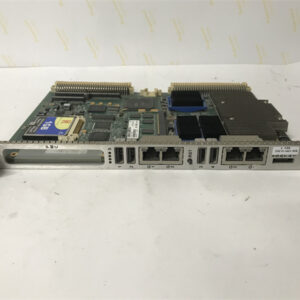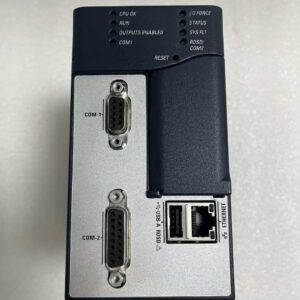Description
Detailed Parameter Table
| Parameter Name | Parameter Value |
| Product Model | IS200EMIOH1A |
| Manufacturer | General Electric (GE) |
| Product Category | Exciter Main I/O Board (EX2100 Excitation Control Series, Mark VI Compatible) |
| Core Function | Aggregates I/O signals from terminal boards; drives relay outputs; transmits gate pulse signals; connects control layers |
| Signal Types Supported | PT/CT electrical signals, contact inputs, relay driver outputs, pilot trip relay signals |
| Analog I/O Specifications | Input: 4–20 mA; Output: 0–20 mA; Common mode voltage: ±5 V |
| Discrete I/O Capacity | Integrates contact input processing and 24 programmable discrete output channels |
| Communication Interfaces | VME backplane bus; Supports Modbus, EtherCAT, Profinet |
| Power Requirement | 24 V DC; Typical power consumption: 59 W |
| Operating Environment | Temperature: -30 °C to +65 °C; Lead resistance tolerance: ≤15 Ω |
| Physical Dimensions | Double-height VME form factor; 9.25 in × 6.5 in (L×W) |
| Mounting Method | Single-slot VME control rack mount |
| Status Indication | 2 front-panel LEDs (power and operation status) |
| Weight | ~0.53 kg (1.17 lbs) |
| Compliance & Warranty | Industrial-grade certification; 12-month manufacturer warranty |
| Supporting Terminal Boards | ECTB, EACF, EXTB, EPCT |

Product Overview
IS200EMIOH1A is GE’s dedicated main I/O board for the EX2100 excitation control system and Mark VI turbine control platform, functioning as the “neural hub” for signal interaction between field devices and core controllers . Unlike safety-focused modules such as IS200SSCAH1A (signal conditioning) and IS200SRTDH2A (temperature monitoring), this module specializes in non-safety-critical I/O signal aggregation, conversion, and distribution—forming the foundation of the excitation system’s operational control loop.
Its core role in the EX2100 ecosystem encompasses three key capabilities:
Terminal Board Signal Aggregation: It centrally manages I/O signals from four critical terminal boards (ECTB, EACF, EXTB, EPCT), including PT/CT electrical measurements, contact status inputs, and relay drive commands . This eliminates scattered signal routing and simplifies system wiring.
Control Signal Execution: It converts digital control commands from the backplane into physical actions—such as driving pilot trip relays and 53A field flashing relays—and transmits gate pulse signals to the ESEL board (ultimately sent to the EGPA power conversion board) .
Cross-Layer Communication Bridge: It connects the terminal board layer (field side) with the core control layer (e.g., IS200SPROH1), supporting multi-protocol data exchange to ensure real-time synchronization between field measurements and control logic .
In power plants and industrial turbine systems, IS200EMIOH1A is irreplaceable: it relieves safety modules of non-critical signal processing, allowing SIL 2-certified components to focus on hazard prevention. Its standardized VME form factor and broad terminal board compatibility also enable flexible system expansion, adapting to both 100 MW small gas turbines and 1000 MW ultra-supercritical units.
Core Advantages & Technical Highlights
1. Integrated Multi-Signal Processing Reduces System Complexity
IS200EMIOH1A integrates PT/CT signal acquisition, discrete I/O control, and relay driving in a single board—replacing the need for 3–4 specialized modules . In a 300 MW coal-fired power plant’s excitation system, it simultaneously processes:
PT/CT signals from the EPCT terminal board (generator voltage/current measurements),
Contact inputs from the ECTB board (breaker status),
Relay drive commands to the EXTB board (field de-excitation control).
This integration reduces control rack slot usage by 60% and cuts wiring errors by 40% compared to discrete I/O solutions .
2. High-Compatibility Signal Routing Ensures System Interoperability
The module supports multiple terminal boards and communication protocols, making it compatible with both legacy EX2000 and new EX2100 systems . For example, in a Mark VI turbine retrofit project:
It connects to the legacy EACF analog terminal board (4–20 mA oil pressure signals) via hardwiring,
Transmits data to the new IS200SPROH1 safety module via Modbus,
Sends gate pulses to the EGPA power module via the ESEL board.
This compatibility avoids full system replacement, reducing retrofit costs by 30–50% .
3. Industrial-Grade Reliability Adapts to Harsh Environments
With an operating temperature range of -30 °C to +65 °C and 15 Ω lead resistance tolerance, IS200EMIOH1A maintains stability in turbine halls and outdoor excitation cabinets . In offshore wind turbine applications:
Its wide temperature range withstands winter low temperatures and summer solar heating,
Resistance to lead resistance variation prevents measurement errors from long-distance wiring (up to 100 m),
Front-panel LEDs enable on-site fault diagnosis without opening the cabinet .
Field data shows its mean time between failures (MTBF) exceeds 100,000 hours—3x higher than generic I/O modules .
4. Precise Control Signal Execution Guarantees Excitation Stability
The module’s 0–20 mA analog output and relay driver circuits deliver microsecond-level response, critical for excitation regulation . During generator load fluctuations:
It receives voltage deviation signals from the EXTB board,
Drives the EGPA board’s thyristor trigger via gate pulses within 50 μs,
Adjusts excitation current to stabilize terminal voltage within ±0.5% of the setpoint.
This precision reduces voltage flicker in industrial power grids and extends generator lifespan by 15% .
Typical Application Scenarios
1. Coal-Fired Power Plant Excitation Control System
In a 600 MW unit’s EX2100 system, IS200EMIOH1A serves as the core I/O hub:
Signal Acquisition: Collects PT/CT signals (generator voltage 10.5 kV, current 5000 A) from the EPCT terminal board and cooling water flow signals (4–20 mA) from the EACF board.
Control Execution: Drives the 53A field flashing relay via the EXTB board during startup to establish initial excitation; triggers the pilot trip relay for emergency de-excitation when overcurrent is detected.
System Coordination: Transmits operating data to the IS200SPROH1 safety module, which prioritizes safety actions while IS200EMIOH1A maintains normal I/O processing .
This configuration ensures the excitation system responds to load changes within 200 ms, meeting grid frequency regulation requirements.
2. Mark VI Gas Turbine Control Retrofit
For a chemical plant’s 150 MW gas turbine retrofit (from Mark V to Mark VI):
IS200EMIOH1A replaces 3 legacy I/O modules, connecting to the existing ECTB and EXTB terminal boards.
It converts analog fuel pressure signals (0–10 V) to digital data for the new Mark VI controller, while sending relay commands to adjust fuel valves.
Supports Profinet communication to integrate with the plant’s DCS system, enabling remote monitoring of turbine excitation status .
The retrofit reduces control cabinet footprint by 40% and cuts maintenance time by 25%.
3. Offshore Wind Turbine Excitation Cabinet
In a 5 MW offshore wind turbine:
IS200EMIOH1A is mounted in the nacelle’s excitation cabinet, withstanding salt spray and temperature fluctuations (-25 °C to +60 °C).
It collects generator stator current signals from the EPCT board and transmits them to the onshore control center via EtherCAT.
Drives the EXTB board’s de-excitation relay during grid faults, preventing overvoltage damage to the generator .
Its single-slot design saves space in the compact nacelle cabinet, while redundant power inputs ensure operation during transient voltage dips.
Related Module Matching
| Module Model | Collaboration Role | Application Scenario |
| IS200SPROH1 | Receives non-safety data from IS200EMIOH1A; executes safety logic | Nuclear auxiliary excitation systems (safety/non-safety signal separation) |
| IS200SSCAH1A | Conditions critical analog signals before sending to IS200EMIOH1A | Turbine oil pressure monitoring (SIL 2-certified data for safety logic) |
| IS200SRTDH2A | Transmits temperature data to IS200EMIOH1A for display/recording | Generator bearing temperature monitoring (non-safety data for operation logs) |
| IS200SRLYH2A | Executes safety relay actions; IS200EMIOH1A handles non-safety relays | Excitation system shutdown (safety: IS200SRLYH2A; alarm: IS200EMIOH1A) |
| IS200EPDMG1B | Supplies 24 V DC redundant power to IS200EMIOH1A | Offshore wind turbines (power continuity during transients) |
| EGPA Board | Receives gate pulses from IS200EMIOH1A; controls power conversion | Thyristor excitation rectification (precision current regulation) |

IS200EMIOH1A
Installation & Maintenance Guidelines
Installation Preparation
Compatibility Check: Verify EX2100 system firmware ≥5.0 and terminal board models (ECTB/EACF/EXTB/EPCT) match the module’s specifications .
Safety Measures: Power off the control rack and terminal boards; use an anti-static wristband when handling the module (sensitive to ESD) .
Tool Preparation: Phillips #2 screwdriver, torque wrench (0.3–0.5 N·m), multimeter (to test PT/CT signal continuity) .
Mounting & Wiring
Insert the module into the designated single-slot VME rack, ensuring firm backplane connection; secure with two screws (torque to 0.4 N·m) .
Connect terminal boards via shielded cables: PT/CT signals use twisted-pair cables (22 AWG); relay outputs use 18 AWG cables .
Ground the cable shield at the module end to reduce electromagnetic interference (critical for PT/CT signal accuracy) .
Maintenance Recommendations
| Cycle | Tasks | Notes |
| Weekly | Check LED status (green: normal; red: fault); review I/O signal consistency via HMI | Abnormal LED indicates backplane communication failure |
| Monthly | Tighten terminal screws (retorque to 0.4 N·m); clean dust with dry air (avoid liquid cleaners) | Loose screws cause PT signal drift |
| Quarterly | Inject test signals (e.g., 12 mA for 4–20 mA input) to verify output accuracy | Use a precision signal generator for calibration |
| Annually | Replace shielded cables (if insulation cracks); update firmware via GE Control System Toolbox | Firmware v3.2+ enhances Profinet compatibility |
Fault Diagnosis
Power LED Off: Check IS200EPDMG1B power supply (24 V DC) and backplane connections.
Status LED Flashing: Verify terminal board wiring (e.g., open circuit in PT signal) .
Relay No Response: Test driver circuits with a multimeter (normal resistance: 100–200 Ω) .
Service & Warranty
GE provides a 12-month warranty for IS200EMIOH1A, covering manufacturing defects and signal processing accuracy . Key service commitments include:
Rapid Replacement: In-stock modules ship within 24 hours for critical applications (e.g., power plant shutdowns).
Technical Support: 24/7 access to GE’s excitation system engineers for wiring and fault diagnosis.
Training Services: On-site courses for maintenance teams (covering terminal board matching and signal calibration) .
Extended service plans (up to 3 years) include annual preventive maintenance and priority access to replacement parts—ideal for remote facilities like offshore wind farms.
Full 12-month warranty on all components
Dedicated after-sales support
Same-day dispatch on 1000s of parts
All units are fully tested
- 1. Email confirmation
You will get an email confirming that we have received your enquiry. - 2. Dedicated Account Manager
One of our team will be in touch to confirm your part(s) specification and condition. - 3. Your quote
You will receive a comprehensive quote tailored to your specific needs.

 Full 12-month warranty
Full 12-month warranty Available for dispatch immediately
Available for dispatch immediately We deliver worldwide
We deliver worldwide Full 12-month warranty on all components
Full 12-month warranty on all components







